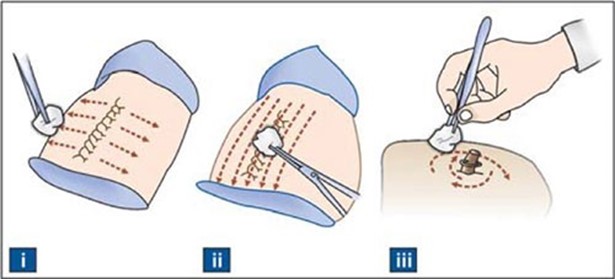A client has been treated for hypertension.
What blood pressure reading indicates to the nurse that the treatment is effective?
84/50 mmHg.
120/77 mmHg.
148/88 mmHg.
160/90 mmHg.
The Correct Answer is B
120/77 mmHg. This is because this blood pressure reading is within the normal range of less than 120/80 mmHg. Hypertension is defined as a blood pressure of 140/90 mmHg or higher.
Choice A is wrong because 84/50 mmHg is too low and may indicate hypotension, which can cause dizziness, fainting, or shock.
Choice C is wrong because 148/88 mmHg is above the normal range and indicates prehypertension, which is a risk factor for developing hypertension and cardiovascular disease.
Choice D is wrong because 160/90 mmHg is above the normal range and indicates stage 1 hypertension, which requires treatment with lifestyle changes and medication.
Nursing Test Bank
Naxlex Comprehensive Predictor Exams
Related Questions
Correct Answer is D
Explanation
Cleanse from the innermost point outwards with a circular movement. This technique reduces the risk of contaminating the wound with bacteria from the surrounding skin.

Some possible explanations for the other choices are:
Choice A is wrong because hydrogen peroxide and betadine solution can damage healthy tissue and delay wound healing.
Choice B is wrong because cleansing the wound from the outer edges towards the center can introduce bacteria from the skin into the wound.
Choice C is wrong because using 4x4 gauze to the wound and surrounding skin three times can cause trauma and bleeding to the wound.
Normal ranges for pressure ulcer stages are:
- Stage I: A reddened, painful area on the skin that does not turn white when pressed.
- Stage II: The skin blisters or forms an open sore. The area around the sore may be red and irritated.
- Stage III: The skin develops an open, sunken hole called a crater or ulcer. The tissue below the skin is damaged.
- Stage IV: The pressure ulcer has become so deep that there is damage to the muscle and bone, and sometimes to tendons and joints.
Correct Answer is ["B","C","D"]
Explanation
Exercise has many health benefits, such as improving self-concept, decreasing resting pulse and blood pressure, and improving sleep quality.
Whether you are a student looking to ace your exams or a practicing nurse seeking to enhance your expertise , our nursing education contents will empower you with the confidence and competence to make a difference in the lives of patients and become a respected leader in the healthcare field.
Visit Naxlex, invest in your future and unlock endless possibilities with our unparalleled nursing education contents today
Report Wrong Answer on the Current Question
Do you disagree with the answer? If yes, what is your expected answer? Explain.
Kindly be descriptive with the issue you are facing.
